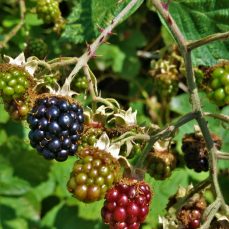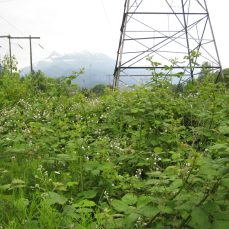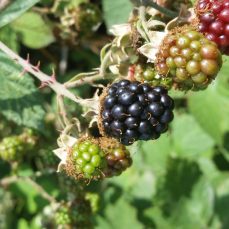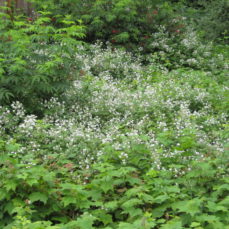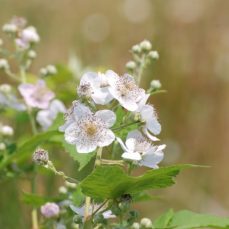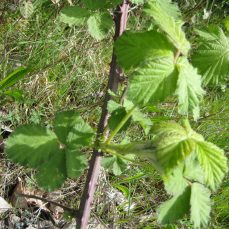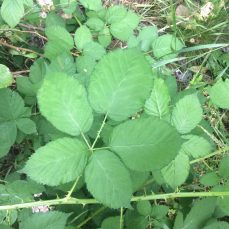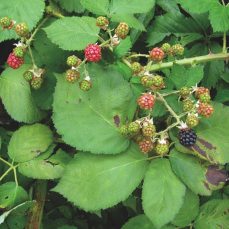
Management Strategy
Squamish
Whistler
Pemberton
Vectors of Spread
ID Characteristics
Flowers: White to pinkish flowers that consist of five staked petals. They are approximately 2.5 cm in diameter, and are arranged in clusters of 5 to 20. The flower stalks are woolly and prickly.
Stems: Thick canes (stems) with sharp, stiff thorns that are green or red and 6 – 10mm long. The canes are arching, growing 6 – 12 m long and 4 – 5 m tall, with deep furrows running down them.
Leaves: Leaves are comprised of 3 to 5 egg-shaped leaflets with toothed edges, a grey, woolly underside, and small prickles on the stalks and mid-veins. Leaves are comprised of 5 leaflets on first-year stems, and 3 leaflets on flowering stems.
Roots: Himalayan blackberry has an extensive system of inter-connected roots that can exceed 10 m in length and 1 m in depth.
Fruits: Ripe berries are black, shiny, and hairless aggregate fruits, usually 1 – 1.5 cm wide. Unripe berries are green or red.
Similar Species
Native:
Black raspberry (Rubus leucodermis) is sometimes confused with Himalayan blackberry. However, it is native to BC and can be recognized by the white residue on its stems (canes).

Black raspberry (Source: Wikipedia)
Trailing blackberry (Rubus ursinus) is the only native blackberry to British Columbia. It is a low, trailing plant with leaves divided into three distinct leaflets that are 15 cm long, dark green on both sides and toothed. Flowers are white or pink and are 2.5 cm wide. Trailing blackberry produces small blackberries and can grow in disturbed sites and dry, open forests at low to mid-elevations, making them prevalent on Vancouver Island and the lower mainland.

Native Trailing Blackberry (Rubus ursinus)
Invasive:
Cutleaf blackberry (Rubus laciniatus) is invasive in British Columbia and can be found throughout the Sea to Sky Region, though it’s not as common as Himalayan Blackberry. Its leaves are medium to dark green, have hairy undersides, and are made up of 5 leaflets that are deeply divided and look lobed with toothy margins.

Credit: LJ. Mehrhoff, bugwood.org
Common blackberry (Rubus allegheniensis) looks similar to Himalayan blackberry, but is slightly smaller, and has leaflets with lightly toothed rather than jagged edges.

Common Blackberry Berries – linkmdavis, iNaturalist
Habitat and Origin
Contrary to what its name suggests, Himalayan blackberry is native to Armenia and Northern Iran. It was introduced to North America in 1885 as a cultivated crop but quickly escaped and became naturalized. It first reached BC in the 1970s.
Himalayan blackberry can be found in wet and moist habitats at low elevations, such in clearings, roadsides, stream banks, wastelands, pastures, forest plantations, and along fence lines.
Himalayan blackberry can colonize a variety of disturbed sites and thrive in a range of conditions.
How it Spreads
Himalayan blackberry is a mostly biennial bramble that reproduces both by seed and vegetatively. Stem tips and cuttings that touch the ground form roots, and new plants can sprout from root buds and nodes found along the stems.
Impacts
Ecological:
- Outcompetes native understory plants.
- Reduces flora diversity through shading.
- Can hinder the growth native tree species that require sun to germinate.
- Infests stream channels and banks, restricting the access of wildlife to waterbodies.
- Degrades pasture and grazing land.
- Increases the likelihood of erosion along banks.
Economic:
- Reduces land value.
- Limits recreational access to waterbodies.
- Reduces sight lines along roadways.
Stop the Spread
Himalayan blackberry is abundant in certain portions of the Sea to Sky region (i.e., in Squamish and south) but has not yet infested all potential habitats. The goal is to contain the spread of Himalayan blackberry to ISMA 1.
Learn to identify Himalayan blackberry: use the images presented in this profile page to learn how to identify it.
What to do if you spot it: You can report any Himalayan blackberry sighting by clicking here.
DO:
- Regularly monitor properties. If you spot it, report it and remove it.
- Play, Clean, Go. Before leaving infested areas, remove and wash off plant material from any equipment, vehicles or clothing. There tend to be designated cleaning sites.
- Check soil, gravel, and fill material is uncontaminated before transport.
- Minimize soil disturbances (e.g., using grazing plants that prevent soil exposure from overgrazing), and use seed mixes with dense, early colonization (e.g., alfalfa or barley) to re-vegetate exposed soil and resist invasion.
- Ensure invasive plant fragments or parts are bagged or covered to prevent spread during transport to designated disposal sites.
DO NOT:
- Plant Himalayan blackberry.
- Unload, park, or store equipment or vehicles in infested areas.
- Place fruit material in the compost.
Control
Because of its food value, SSISC’s approach is to only use mechanical methods to control invasive Himalayan blackberry, except at a handful of special case sites, which are not accessible to the public.
Mechanical
Mechanical removal (i.e., removing all parts of the plant, including the roots) is an effective way to control this species. The canes must be cut or pulled before berries are produced, and the roots of the plant must be removed with hand tools or machinery to prevent regrowth. Regularly mowing can reduce the biomass but won’t kill Himalayan blackberry.
Chemical
Himalayan blackberry can be treated in late summer or fall with various herbicides. Although this can be an effective control method, the dry and hard canes will need to be removed to allow access for effective restoration.
We recommend that any use of herbicides must be applied by a person holding a valid BC Pesticide Applicator Certificate. Before selecting and applying herbicides, you must review and follow herbicide labels and application rates; municipal, regional, provincial and federal laws and regulations; species-specific treatment recommendations, and site-specific goals and objectives.
Integrated
The integration of mechanical control methods (cutting) with either the chemical treatment of stumps or follow-up herbicide application offers the most success.
Biological
Grazing by goats has proven effective, and chickens can remove the seeds from an area.
Sea to Sky Distribution
Himalayan Blackberry Factsheet
Having trouble viewing the factsheet? Don’t worry, all the information is included on this page. You can also contact us with any questions.
Additional Resources
How to Identify Himalayan Blackberry:
References
- Centre for Invasive Species and Ecosystem Health, Controlling Himalayan Blackberry in the Pacific Northwest
- Electronic Atlas of the Flora of BC, Rubus armeniacus
- Invasive Species Council of BC, Himalayan Blackberry
- Invasive Species Council of BC, Himalayan Blackberry TIPS Factsheet
- King County, Himalayan Blackberry identification and control
- Metro Vancouver and Invasive Species Council of Metro Vancouver, Best Practices for Himalayan Blackberry in the Metro Vancouver Region
- Metro Vancouver and Invasive Species Council of Metro Vancouver, Tackling Himalayan Blackberry
- US Department of Agriculture Fire Effects Information System, Rubus armeniacus, R. bifrons
- US Department of Agriculture, Field Guide for Managing Himalayan Blackberry in the Southwest
- Washington State Noxious Weed Control Board, Himalayan Blackberry








